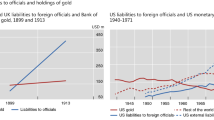Abstract
During the quarter century of severe U.S. monetary inflation starting in the mid-1990s, the rest of the world failed to implement defensive strategies against its spread. In contrast, during the U.S.’ greatest peacetime inflation from the late 1960s to the late 1970s, there was powerful and increasingly successful defence against the spread of monetary inflation by the U.S. hegemon, most notably in Germany. How to explain the difference? This latest episode of monetary inflation had a larger manifestation in asset inflation and a smaller one in goods and services inflation. Asset inflation enjoyed considerable popularity in its sometimes long active phase, before the bust phase and aftermath. Moreover, there is no widespread recognition of how asset inflation takes its toll eventually on economic prosperity while high goods and services inflation generates much popular resentment. The most effective defence strategies against the spread of asset inflation from the U.S. hegemon are in countries where the monetary regime can be firmly anchored independent of the dollar. Defence cannot be total given that asset inflation has greater potential than goods and services inflation to cross currency frontiers. Even so, well-designed defence can limit substantially the damage to national prosperity from the U.S. monetary hegemon pursuing virulent U.S. asset inflation. The paper concludes with case-studies on why three countries, Japan, Switzerland and Israel, failed to erect effective defences during the most recent episode of U.S. monetary inflation.
Similar content being viewed by others
References
Brown, B. (2017). Goods Inflation, Asset Inflation, and the Greatest Peacetime Inflation in the US. Atlantic Economic Journal, 45(4), 429–442.
Brown, B. (2018). The Case Against 2 Percent Inflation. London: Palgrave Macmillan.
Brown, B., & Simonnot, P. (2020). Europe’s Century of Crises under Dollar Hegemony. London: Palgrave Macmillan.
James, H. (2014). Making the European Monetary Union. Cambridge: Belknap Press.
Rich, G. (1997). Monetary Targets as a Policy Rule: Lessons from the Swiss experience. Journal of Monetary Economics, 39(1), 113–141.
Ueda, K., Hamada, K., & Beebe, J.H. (1993). Japanese Monetary Policy from 1970 to 1990: Rules or discretion. In: K. Shigehara (Ed.), Price Stabilization in the 1990s, London: Palgrave Macmillan.
Voth, H. J. (2003). With a Bang, Not a Whimper: Pricking Germany’s Stock Market Bubble in 1927 and the Slide into Depression. Journal of Economic History, 63(1), 65–99.
Author information
Authors and Affiliations
Corresponding author
Additional information
Publisher's Note
Springer Nature remains neutral with regard to jurisdictional claims in published maps and institutional affiliations.
Rights and permissions
About this article
Cite this article
Brown, B. Why Has Foreign Monetary Resistance to the Inflationary Dollar Hegemon Been So Weak in the Past Quarter Century (1995-)?. Atl Econ J 49, 127–141 (2021). https://doi.org/10.1007/s11293-021-09717-2
Accepted:
Published:
Issue Date:
DOI: https://doi.org/10.1007/s11293-021-09717-2
Keywords
- Monetary inflation
- Asset inflation
- U.S. monetary hegemon
- Monetary anchors
- Swiss monetarism
- German monetarism



